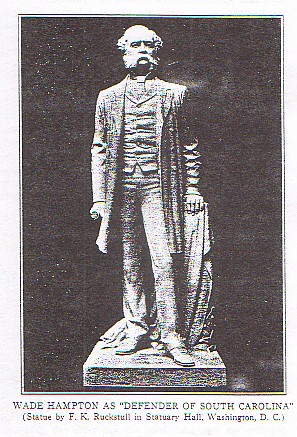1898 Wilmington Race Riot
The Red Shirts of 1898:
Red Shirt Riders:
Who were the “Red Shirts,” a group vilified by revisionist writers about 1898 Wilmington? As a group, they appear in various accounts of 1898 Wilmington as participants in the conflict, and many brought here from neighboring counties to help quell the violence and bring order back to the city. As will be seen below, the Red Shirts have a history of opposing corrupt Republican regimes that dominated Southern postwar politics and reinstituting responsible government. They were no doubt drawn to Wilmington for the same reasons, and to a city that suffered from Reconstruction longer than any other Southern city.
The origins of the "Red Shirt" can be traced to Mississippi in 1875 (The South During Reconstruction, E. Merton Coulter, page 358) by Conservative rifle clubs who wanted to make themselves conspicuous to black Republicans; and later found in the South Carolina gubernatorial campaign of Wade Hampton in 1876, with the first historical evidence of the red shirt there being on August 25th of that year. As quoted from "Hampton And His Red Shirts" (Alfred B. Williams, 1935), "The most important happening of this special period of the campaign was the actual introduction of the red shirt as a uniform. "Hampton's Red Shirts" are a part of the history not only of South Carolina but of the country." The color of the shirt was a derisive response to radical Republican politicians and their "reliance on the bloody shirt (of the Northern war veteran) as a preeminent political weapon." The North Carolinian "Red Shirts" saw themselves in a similar role as Wade Hampton's supporters in 1876--saving their State and City from the horrors of Reconstruction and Republican political corruption.
A Red Shirt Parade in Wilmington:
“The first Red Shirt parade on horseback ever witnessed in Wilmington electrified the people today. It created enthusiasm among the whites and consternation among the Negroes. The whole town turned out to see it. It was an enthusiastic body of men. Otherwise it was quiet and orderly.
(Raleigh News & Observer, November 4, 1898.)
The following extracts from various resources help us to understand the origins and meaning behind the Red Shirts in South Carolina, why they existed and how they influenced the 1898 conflict in Wilmington.
This excerpt from “Wade Hampton” by author Walter B. Cisco reveals that during the 1876 gubernatorial campaign in South Carolina, former Confederate General Wade Hampton had many black supporters, which included black Confederate soldiers who wanted the carpet-bag regime out of South Carolina.
 |
Governor Wade Hampton |
Wade Hampton:
“Hampton was now in that region of South Carolina where blacks made up 90 to 95 percent of the population. At Early Branch, Hampton was met at the station by a Red Shirt escort that included a contingent of blacks. Among these black Red Shirts may have been the “mounted black cadre,” a group that traveled to join Hampton at some of his campaign stops around the State. Several in the cadre were black Confederate veterans. The Garden Corner Campaign Club, a black choral group, sang songs “each having as its theme the good time coming when the thieves and disturbers would be sent away, honest folk would conduct the government and the races would be at peace.” So many black supporters appeared at Hampton meetings that some Northern Republicans would claim that they must be servants of the speakers, or paid to be there. It was even charged that whites put on burnt cork and donned wigs to impersonate black Democrats.
In Charleston…”the appearance of General Hampton aroused a perfect hurricane of cheers,” as the candidate rode in the carriage drawn by four matched horses. There were Red Shirts, black and white, from the Cooper River rice fields. Another contingent, again of both races, wore red shirts and black sombreros.
Along the parade route, (Republican) black women hurled obscenities and brickbats at black Democrats. “No serious harm was done,” wrote a reporter, “and the (black) Democrats bore with equanimity the cheers of the Republican slaves.”
Hampton made a trip by boat to a meeting in Georgetown…A stand amid the pine trees was the center of “two hours of cheers, music, marching, flowers, flags and a general swirl of enthusiasm.” An unusually large number of black Red Shirts lifted Democratic spirits.
In Columbia, “the parade was led by one hundred mounted Red Shirts---fifty white and fifty black.
Always, his appeal was directed first to the black voter. “I have not said one word,” Hampton told the Columbia crowd, “ that could hurt the feelings of a colored man or woman.” With the day of triumph approaching, “we will owe this victory in great part to the colored man.”
Wade Hampton, Walter Brian Cisco, Brassey’s Inc., 2004, pp. 239-244
Sources and Recommended Reading:
The South During Reconstruction, E. Merton Coulter, LSU Press, 1947
Wade Hampton, Walter Brian Cisco, Brassey's Inc., 2004
Hampton And His Red Shirts,
Alfred B. Williams, Crown Rights Books, 1935/2001
Wade Hampton and the Negro, Hampton M. Jarrell,
University of South Carolina Press, 1949.